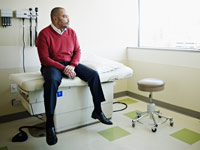Staying Fit
l For years, Marcia Andrews visited the same internist in Washington, D.C. Then she turned 65, got her Medicare card and had to find a new doctor: Her internist was not accepting Medicare patients. Primary care doctors are in such demand now that they can choose not to accept Medicare, whose reimbursements to physicians are lower than private insurance rates.


"The doctor shortage is worse than most people think," says Steven Berk, M.D., dean of the School of Medicine at Texas Tech University. "The population is getting older, so there's a greater need for primary care physicians. At the same time, physicians are getting older, too, and they're retiring earlier," Berk says. And graying doctors — nearly half the nation's 830,000 physicians are over age 50 — are seeing fewer patients than they did four years ago, a 2012 Physicians Foundation survey reported.


AARP Membership— $12 for your first year when you sign up for Automatic Renewal
Get instant access to members-only products and hundreds of discounts, a free second membership, and a subscription to AARP the Magazine.
Soon, this fraying primary care network will face another huge challenge: Under the Affordable Care Act, millions of formerly uninsured men and women will have access to health care.
"We need to absorb these 30 million people, and that's going to be a strain," says Russell Phillips, M.D., director of Harvard Medical School's new Center for Primary Care.
A fundamental change
The approach most favored by experts at Harvard and elsewhere is to reshape traditional primary care: from a stream of patients waiting to see one harried doctor to a more efficient team practice in which patients with routine problems are seen by nurse-practitioners and physician assistants — trained specialists with master's degrees. The team frees the doctor to spend more time with patients with more serious complaints.This change could be as fundamental as the one that took place when most family doctors stopped making Marcus Welby-like house calls.
The Affordable Care Act encourages such a sea change, with provisions that aim to shore up and expand the country's ailing primary care system while still reducing costs.
The ACA authorizes money to increase the primary care workforce by training more doctors, nurses, nurse-practitioners and physician assistants. It includes more graduate medical education training positions, with priorities for primary care and general surgery, and more money for scholarships and loans for all health professionals. The law expands the number of patients seen at community health centers in areas with too few doctors and increases the number of staffers who work in the centers. It also expands nurse-managed clinics at nursing schools where nurses in training see patients who live in the area.
Another key provision: a 10 percent bonus, through 2015, to primary care doctors who offer services to Medicare patients.
But in these times of shrinking federal budgets, it's unclear how much ACA primary care money will be available as Congress juggles competing priorities. Congress, for example, already has chopped about $6.25 billion from the ACA's new $15 billion Prevention and Public Health Fund, which pays for programs to reduce obesity, stop smoking and otherwise promote good health. In addition, federal support for training all types of physicians, including primary care doctors, is targeted for cuts by President Obama and Congress, Republicans and Democrats, says Christiane Mitchell, director of federal affairs for the Association of American Medical Colleges, who calls the proposed cuts "catastrophic."

































































More on health
Medicare Eligibility: Age, Qualifications, Requirements
Here are the requirements to be eligible for health care coverageCouple Loses Health Coverage Over Pennies
Policy canceled for being 2 cents short in one payment.